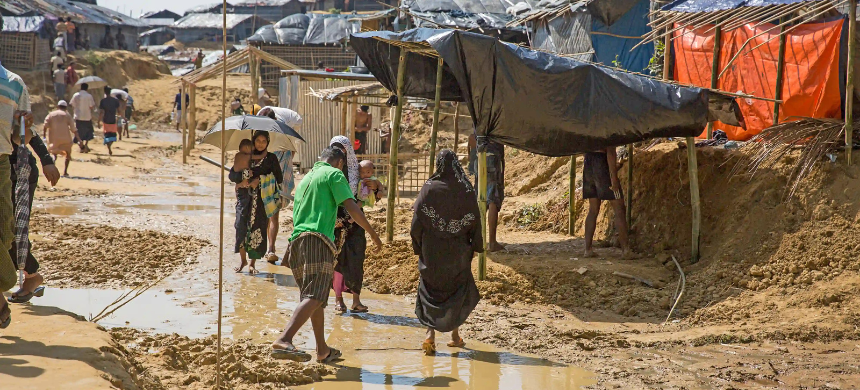The Rise of Climate Refugees in Pakistan: A Growing Crisis
Imagine waking up to the deafening roar of floodwaters surging through your door or the relentless heat that decimates your crops, leaving nothing but dry earth in its wake. For millions of Pakistanis, this isn’t a distant nightmare but an increasingly frequent reality, driven by the escalating force of climate change.
The phenomenon of climate refugees—individuals displaced within their own country due to climate-related disasters—is no longer a theoretical concept. It’s a harsh and tangible reality that has already displaced millions, placing immense pressure on Pakistan’s fragile infrastructure, economy, and social fabric.
The Emerging Threat of Internal Displacement
While the term “climate refugee” might evoke images of people fleeing across borders, Pakistan is witnessing a far graver scenario: a growing wave of internal migration. As monsoon rains grow erratic and heatwaves devastate crops, the harsh consequences of climate change are most deeply felt in rural areas. These individuals are not just victims of natural disasters; they are the early casualties of the global climate crisis.
In Sindh, Balochistan, and Khyber Pakhtunkhwa, entire communities have been displaced as floodwaters ravage homes, crops, and infrastructure. In drought-prone areas like the Thar Desert, families are forced to leave their ancestral lands in search of food and water as the land turns barren. Displacement in Pakistan is not limited to sporadic extreme events but is intricately tied to the slow, relentless onset of climate change, which steadily erodes livelihoods, pushing people to urban centers for survival.
The Personal Faces of Climate Displacement
The term “climate refugee” might sound abstract in policy discussions, but these refugees have real lives, real families, and real struggles. Laila, a mother of three from the Thar Desert, exemplifies this tragic reality. For years, her family relied on farming, dependent on the once-predictable monsoon rains. However, in recent years, rainfall has become increasingly unpredictable. In 2018, a severe drought forced her family to abandon their ancestral land and migrate to Karachi, where they now live in a makeshift slum, struggling to secure basic necessities.
Laila’s story is mirrored by thousands of families in flood-prone regions of Pakistan. After the devastating 2022 floods, more than 33 million people were affected, and millions were forced to leave their homes. According to Pakistan’s National Disaster Management Authority (NDMA), the floods wiped out 8 million acres of crops and displaced 4.5 million people in Sindh alone.
Read More: Pakistan and China Unite Against Climate Change Challenges
The Scope of the Crisis
To truly grasp the gravity of this crisis, consider these statistics. In 2022, 3.5 million Pakistanis were displaced due to climate-related disasters, according to the Global Internal Displacement Monitoring Centre (IDMC). But this number doesn’t even account for the long-term effects of slow-onset disasters like droughts, which displace people over extended periods.
By 2050, it is estimated that up to 10% of Pakistan’s population—around 24 million people—could be displaced due to the impacts of climate change. This mass displacement threatens to overwhelm Pakistan’s already strained infrastructure, particularly in urban centers like Karachi and Lahore.
The Economic and Human Cost
The economic toll of climate-induced displacement is staggering. The 2010 floods caused damage estimated at $10 billion, and experts predict the 2022 floods may have resulted in $15–20 billion in damages. This includes devastation to infrastructure, agriculture, and public health, with the poorest and most vulnerable communities bearing the brunt of the impact.
Beyond the immediate recovery costs, the long-term consequences are equally concerning. Displaced populations often migrate to overcrowded urban areas, where access to education, healthcare, and employment is limited. This places additional strain on already struggling local economies and urban infrastructures, driving up poverty levels and fueling social unrest.
The human cost is equally profound. Displaced communities often live in makeshift shelters or overcrowded camps with limited access to clean water, sanitation, and healthcare. As a result, diseases like cholera, malaria, and respiratory infections spread rapidly, further exacerbating the crisis. The World Health Organization (WHO) reported over 200,000 cases of waterborne diseases in the aftermath of the 2022 floods.
The displacement of children is particularly concerning, as 2.5 million children were unable to attend school following the 2022 floods. This loss of education severely hampers their future prospects, perpetuating the cycle of poverty and vulnerability.
What Needs to Be Done?
The growing wave of internal displacement in Pakistan calls for urgent action. To prevent further crises, Pakistan must adopt a more proactive approach to disaster management, focusing on adaptation and resilience rather than merely responding to disasters after they occur.
- Early Warning Systems: Investing in early warning systems can help predict and mitigate the effects of floods, heatwaves, and droughts, giving communities time to evacuate and prepare.
- Resilient Infrastructure: Constructing climate-resistant housing and flood defenses will help reduce vulnerability to future climate-related disasters.
- Economic Reintegration Programs: Providing displaced individuals with vocational training, microfinance, and employment opportunities in sustainable sectors, like renewable energy and climate-resilient agriculture, can help them rebuild their lives.
- International Collaboration: Pakistan must work with international partners such as the UN and the World Bank to secure funding and expertise for climate adaptation strategies.
Conclusion
The crisis of climate refugees in Pakistan is not just a humanitarian emergency; it is a profound challenge that threatens the nation’s future. The numbers are staggering, the human toll is immense, and the need for action is immediate. By focusing on resilience, disaster preparedness, and long-term solutions for displaced communities, Pakistan can mitigate the worst effects of climate change and secure a sustainable future for all its people.
The time to act is now—before the next flood or drought forces another family, like Laila’s, to abandon everything they know in search of a better life.











